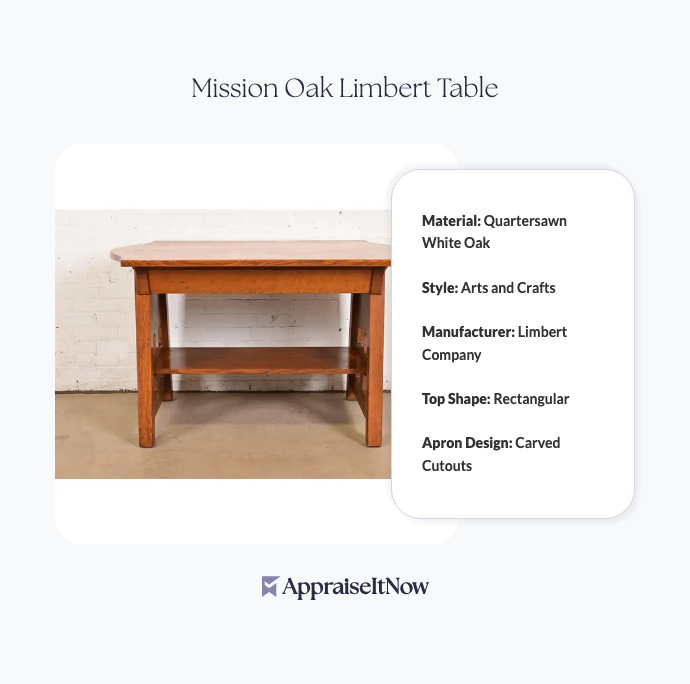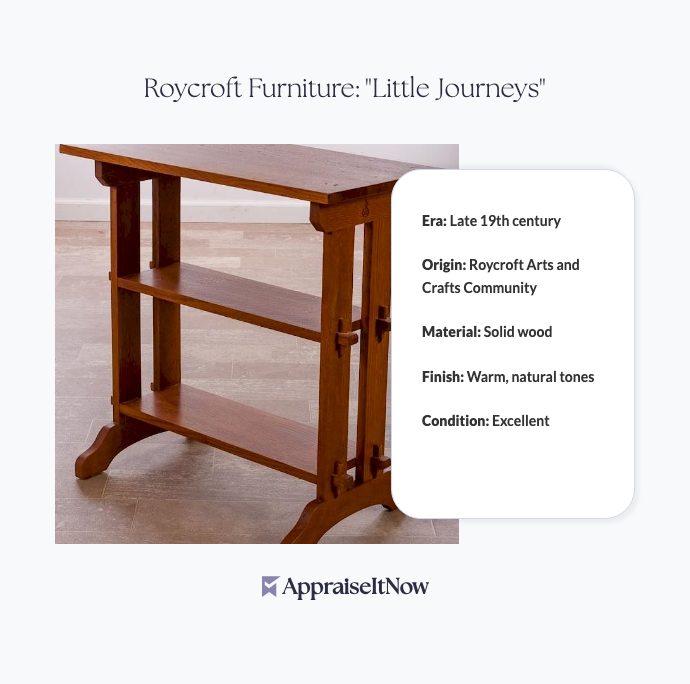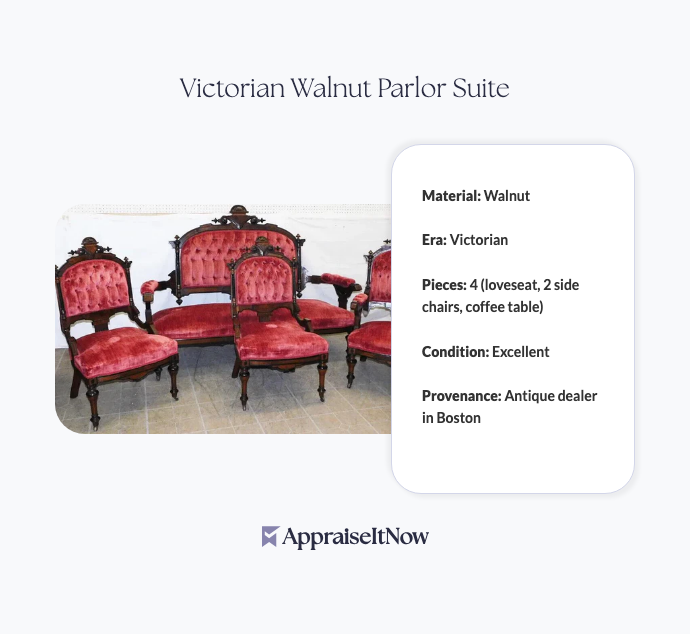<h1>How to Get Your Mission Oak Limbert Table Appraised</h1>
<p>The Mission Oak Limbert Table stands as a timeless example of American Arts and Crafts design, and if you own one of these handcrafted pieces, understanding its value requires professional expertise. Whether you're considering selling, seeking insurance coverage, or simply curious about what your table is worth, a proper appraisal provides the documentation and confidence you need. With current market estimates ranging from $4,500 to $7,000 for quality examples, knowing how to navigate the appraisal process ensures you capture accurate value.</p>
<h2>Understanding Mission Oak Limbert Table Value</h2>
<p>Your Mission Oak Limbert Table represents more than just furniture—it's a collectible piece of American design history. Handcrafted in Grand Rapids, Michigan starting in 1903, the Limbert Company produced only approximately 500 pieces worldwide of this signature design, making scarcity a significant value driver. The table's distinctive cutout design along the apron, constructed from solid quartersawn white oak, exemplifies the clean lines and intricate joinery that define the Arts and Crafts movement.</p>
<p>The question "how do I find the value of an antique table?" leads many collectors directly to market research, but professional appraisals provide something more valuable than online price guides. Certified appraisers examine construction quality, originality, condition, and provenance—factors that determine whether your Limbert table sits at the lower or upper end of the $4,500-$7,000 range.</p>
<div class="callout tip"><p><strong>Collector's Insight</strong></p>
<p>Limbert tables with original finish, signed maker's marks, and documented ownership history often command premiums of 15-25% above average market values.</p></div>
<h2>What Makes a Mission Oak Limbert Table Desirable</h2>
<p>Understanding value drivers helps you contextualize your piece within the broader antique furniture market. The Limbert Company's reputation for exceptional craftsmanship, combined with the Arts and Crafts movement's enduring appeal, ensures steady collector demand. Your table's rectangular top features beautiful carved cutouts showcasing signature Limbert design elements, while sturdy tapered legs and lower stretchers provide both aesthetic appeal and structural integrity that has survived over a century.</p>
<p>The construction methodology itself affects desirability. Limbert pieces employ mortise and tenon joinery—a labor-intensive technique that produces superior strength and longevity compared to inferior assembly methods. When you're wondering "how do I know if my old desk is valuable?" or evaluating any piece from this era, construction technique becomes a primary indicator of quality and investment potential.</p>
<table class='appraisal-table'>
<thead>
<tr>
<th>Limbert Table Feature</th>
<th>Value Impact</th>
<th>Details</th>
</tr>
</thead>
<tbody>
<tr>
<td>Signed maker's mark</td>
<td>+20-25%</td>
<td>Authentic Limbert Company verification</td>
</tr>
<tr>
<td>Original finish</td>
<td>+15-20%</td>
<td>Versus refinished or restored examples</td>
</tr>
<tr>
<td>Matching stretchers</td>
<td>+10-15%</td>
<td>No replaced or repaired components</td>
</tr>
<tr>
<td>Size and proportion</td>
<td>Varies</td>
<td>Larger tables typically command premiums</td>
</tr>
</tbody>
</table>
<h2>Determining Authenticity and Condition</h2>
<p>Before seeking formal appraisal, you'll want to establish whether you're examining a genuine Limbert piece or a contemporary reproduction. "How to tell if a table is an antique?" requires examining specific markers. Authentic Limbert tables feature hand-planed surfaces with subtle irregularities, period-appropriate hardware, and construction techniques consistent with 1903-1920s production. The characteristic cutout design in the apron—often featuring geometric or nature-inspired patterns—should display handwork evidence rather than machine precision.</p>
<p>Condition assessment directly influences appraisal value. Professional appraisers evaluate surface finish, structural integrity, drawer function if applicable, and any repairs or replacements. Minor wear consistent with age adds character and authenticity; however, significant damage, loose joints, or extensive refinishing can reduce value substantially. Understanding this distinction helps you decide whether restoration efforts before appraisal might be worthwhile.</p>
<div class="callout note"><p><strong>Appraisal Consideration</strong></p>
<p>While technology offers convenience, asking "is there an app to scan antiques for value?" misses the nuance that certified appraisers bring. Professional evaluation of household goods and personal property requires hands-on inspection and market expertise that automated systems cannot replicate.</p></div>
<h2>Preparing Your Limbert Table for Professional Appraisal</h2>
<p>Getting accurate value starts with proper documentation. Before contacting an appraiser, photograph your table from multiple angles—top view, side profiles, detail shots of the cutout design, maker's marks, and any signatures or labels. Include photographs showing the table's overall condition, including any wear, repairs, or unusual features. This visual documentation allows appraisers to conduct preliminary assessment and helps you communicate details clearly.</p>
<p>Measure your table's dimensions (height, width, depth) and document the wood type and finish condition. Create a brief written description noting when and where you acquired the piece, any family history or provenance information, and what you know about its prior ownership. These details matter significantly—a Limbert table with clear ownership records from early collectors differs substantially in value from one lacking documentation, much like understanding that industry standards help professionals establish fair market positioning.</p>
<h2>The Role of Professional Appraisers in Furniture Valuation</h2>
<p>When you're ready to seek professional assessment, understanding the difference between casual estimates and certified appraisals becomes important. A professional appraiser provides a detailed, documented evaluation suitable for insurance purposes, estate planning, or transaction verification. Our specialists at AppraiseItNow are credentialed by organizations including AAA, ISA, ASA, CAGA, and AMEA, ensuring expertise in antique furniture appraisal methodology.</p>
<p>Certified appraisers follow USPAP standards (Uniform Standards of Professional Appraisal Practice), which mandate thorough market analysis, comparable sales research, and detailed documentation. This rigorous approach means you receive not just a number, but a comprehensive report explaining the reasoning behind your Limbert table's valuation. Such documentation proves invaluable for insurance claims, estate distributions, or charitable donations.</p>
<div class="callout tip"><p><strong>Pro Tip</strong></p>
<p>Professional appraisals typically cost $200-$500 depending on complexity and location, but this investment pays dividends through accurate valuation that protects your asset and provides documentation for multiple purposes.</p></div>
<h2>Market Trends and Collector Interest</h2>
<p>The question "what is the most sought after antique furniture?" reveals that Mission and Arts and Crafts pieces occupy prominent positions in today's market. Younger collectors increasingly appreciate the design philosophy and handcrafted quality of early-20th-century furniture, driving sustained demand. Limbert pieces specifically benefit from their American origin, geometric design appeal, and the movement's alignment with contemporary preferences for sustainable, well-made furnishings.</p>
<p>Market trends suggest steady appreciation for authentic Arts and Crafts pieces in good condition. Unlike mass-produced furniture where age alone doesn't guarantee value, Limbert tables continue appreciating because of limited original production combined with growing recognition of their design importance. Whether you're asking "is 70 year old furniture an antique?" or "is 50 years old vintage or antique?", the answer involves understanding that Limbert tables from 1903-1920s classify as genuine antiques by virtually any definition, conferring automatic historical significance.</p>
<h2>Why Professional Documentation Matters</h2>
<p>Seeking quality appraisals for your Mission Oak Limbert Table connects to broader asset management principles. Just as personal property appraisals support insurance coverage and business assets require valuation for operational purposes, furniture appraisals establish legal documentation of worth. If you're wondering "is there an app to take a picture and see how much something is worth?"—technology offers initial guidance, but certification requires expertise that certified professionals alone can provide.</p>
<p>Your appraisal documentation becomes particularly valuable if you need to file insurance claims, settle estate disputes, or establish value for charitable donations. Professional reports include condition photographs, provenance research, comparable sales analysis, and market positioning—comprehensive documentation that casual estimates or online searches simply cannot match. When exploring resources on how to document your furniture for appraisal purposes, you're investing in protections that extend far beyond initial valuation.</p>
<h2>Connecting Your Appraisal to Broader Asset Strategy</h2>
<p>Understanding your Limbert table's $4,500-$7,000 value connects to comprehensive asset management. Whether you're evaluating household goods for insurance, cataloging personal property for estate planning, or researching antique furniture collectibility, professional appraisals provide the authoritative foundation. These certified valuations align with broader understanding of value in terms of quality and rarity, ensuring your collection receives proper recognition.</p>
<p>For those exploring how to get an accurate antique furniture appraisal, the process combines visual inspection, historical research, market analysis, and expert judgment. Your Limbert table's story—from Grand Rapids handcraftsmanship to contemporary collectibility—deserves documentation that captures both its monetary and cultural significance. Professional appraisers understand this distinction and deliver reports that address both practical valuation needs and historical context.</p>
<div class="callout note"><p><strong>Key Takeaway</strong></p>
<p>A certified appraisal of your Mission Oak Limbert Table provides authoritative documentation of its $4,500-$7,000 value while establishing the historical significance and condition details essential for insurance, sale, estate planning, or collection management. Professional expertise ensures accurate valuation that reflects current market dynamics and your piece's unique characteristics.</p></div>







.avif)







